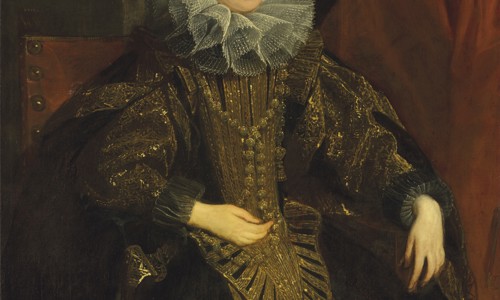
Glasgow Life acquires notable painting by Anthony van Dyck
Glasgow Life acquires notable painting by Anthony van Dyck
6 October 2021
Glasgow Life has acquired an impressive and little-known painting by one of the great Flemish Old Master painters, Sir Anthony van Dyck, entitled Marchesa Lomellini. This is the first Van Dyck to enter the City’s collection
Painted in Italy between 1621 and 1627 it features a young Marchesa Lomellini, a member of the noble Lomellini family of Genoa. The striking portrait showcases van Dyck’s skilful ability to depict lifelike human expressions and intricate costume.
The painting will be on display in the Looking at Art gallery in Kelvingrove Art Gallery and Museum from Thursday 18 November.
The outstanding artwork comes from the collection of Sir Ilay Mark Campbell, 7th Baronet of Succouth (1927-2017) and Lady Campbell. Lady Campbell and her family generously offered the painting to Glasgow Museums Collection, which is cared for by the charity Glasgow Life, as part of the Acceptance in Lieu Scheme, administered by Arts Council on behalf of the UK Government.
Chair of Glasgow Life, Councillor David McDonald, said:
We are thrilled to accept this significant painting. Acquisitions are a source of excitement, celebration and inspiration and now more than ever, they highlight the contribution art and culture play in peoples’ wellbeing.
Until now Glasgow did not have a painting by van Dyck. This portrait, by an internationally important Old Master painter, greatly strengthens our world-class fine art collection and connects well with other paintings we have on show. Not only will it attract much attention from regular visitors, but given the excellent standard of the painting, together with the international importance of the artist, it is likely to draw tourists from across the world now they are safely able to travel to Glasgow once again.
The Cabinet Secretary for Culture Angus Robertson said:
The Acceptance in Lieu scheme is an excellent way to enrich the range of internationally renowned paintings and artefacts that are available for everyone in Scotland to enjoy.
The donation of Sir Anthony Van Dyck’s unique Portrait of A Lady to Glasgow for display at its Kelvingrove Art Gallery and Museum is extremely welcome, particularly as it is the first painting by this artist to enter the city’s collection. This is an important and valuable acquisition, one which I hope will give great joy to many people.
Edward Harley, OBE, Chairman, Acceptance in Lieu Panel, said:
I am delighted that this painting by Sir Anthony van Dyck has been acquired by Glasgow City Council through the Acceptance in Lieu Scheme where it will be displayed at Kelvingrove Art Gallery and Museum. This portrait, possibly of the Marchesa Lomellini, dates from the artist’s six-year stay in Italy, an important period of his work which is not often seen in British collections. I am pleased to say that this will be the first painting by Van Dyck to enter a collection in Glasgow. I hope that this example will encourage others to use the scheme to find a place for great art in our national collections.
The painting’s rich provenance links with Scottish artist and art dealer Andrew Wilson, who acquired the work from the Lomellini family, as part of a series of exceptional Genoese portraits bought in Italy in 1828. The painting once hung in the same room at Palazzo Lomellini as the most ambitious of all van Dyck’s Genoese portraits, the Lomellini Family (Edinburgh, National Gallery of Scotland).
It was then purchased by Sir Archibald Campbell of Succoth, 2nd B. (1769-1846), of Garscube House, near Glasgow, where it hung in the Dining Room. His great-grandson, Sir George Campbell of Succoth, 6th Bt. (1894-1967) lent it to the city of Glasgow as a long term long where it hung in Kelvingrove Art Gallery and Museum from 1946-76, before it was inherited by the late Sir Ilay Campbell of Succoth.
The painting will be at home amongst Glasgow Lifes’ other great Dutch and Flemish portraits, including notable examples by Rubens, Jacob Jordaens, Hans, van der Helst and self-portraits by Rembrandt and Flinck.
The Acceptance in Lieu scheme was founded in 1910 and allows donors to offset their inheritance tax liabilities by leaving objects of cultural, historical or artistic significance to the public. A panel of experts determines the value of each work and allocates it to a public institution. AIL is a key element in the government's strategy to ensure the nation’s most important art, objects and manuscripts remain within the UK and become accessible to the public. Last year, objects worth over £60 million were allocated to museums, galleries and archives within the UK and over the last decade the amount has totalled £423 million.
Van Dyck was born in Antwerp, Belgium in 1599 and went on to become one of the most important painters of the 17th century. His works were influenced by fellow Flemish artist Rubens and other European painters, most notably Italian artist Titian. As a young artist, van Dyck spent six years in Italy, from 1621 to 1627. He was an extremely successful portraitist and painter of religious and mythological pictures, and an accomplished draughtsman and etcher. After success in Italy, where he painted Marchesa Lomellini, he became the leading court painter in England and is now best remembered for his elegant representations of Charles I and his court. He died in 1641.
The Looking at Art gallery on the ground floor of Kelvingrove, off the main hall, offers an opportunity to consider artworks from all different time periods and in a variety of styles in a thematic arrangement. The van Dyck will be hung in the People section of the gallery alongside a painting by near-contemporary English Baroque portraitist John Michael Wright (1617-94), and portraits by Pre-Raphaelite Dante Gabriel Rossetti (1828-82) and British Vorticist Wyndham Lewis (1882-1957).
